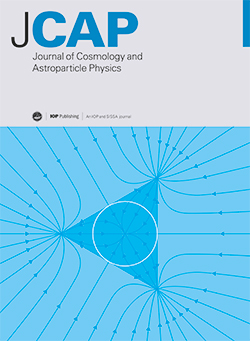LISA中的恒星质量黑洞双星:特征和与当前一代干涉仪的互补
IF 5.3
2区 物理与天体物理
Q1 ASTRONOMY & ASTROPHYSICS
Journal of Cosmology and Astroparticle Physics
Pub Date : 2025-01-21
DOI:10.1088/1475-7516/2025/01/084
引用次数: 0
摘要
恒星质量的双黑洞是迄今为止观测到的数量最多的引力波源。它们的特性使它们适合于地面和太空探测器的观测。本文从基于地面探测器观测约束构建的合成星表出发,以信噪比阈值作为探测准则,探索LISA观测到的恒星质量黑洞双星在其激发过程中的探测率和特征参数。我们发现,这些源中只有少数能够被探测到,信噪比大于8:在4年的任务持续时间内,平均约有5个源,其中只有一两个是多波段的(即在不到15年的时间内合并)。我们发现可探测到的源的啁啾质量为10 M⊙> c > 100 M⊙,剩余聚并时间为4 yr > τc > 100 yr,红移z > 0.1,比目前地面探测器观测到的更接近。我们还探讨了LISA可探测源的数量与总体参数之间的相关性,表明与随机信号的联合测量可能提供总体特征的信息。通过对星表中的一部分源进行参数估计,我们得出结论,即使LISA测量结果由于可解析源的数量少而不能直接提供总体信息,它也将以极高的精度表征一些低红移候选者。此外,我们首次构建了低啁啾质量系统的LISA瀑布图,作为它们的聚并时间和倾角的函数。我们证明,通过非常精确的参数估计,LISA也将能够在地面探测器灵敏度的边界上区分和表征具有更高质量的双星群,即c ~ (103) M⊙。本文章由计算机程序翻译,如有差异,请以英文原文为准。
Stellar-mass black-hole binaries in LISA: characteristics and complementarity with current-generation interferometers
Stellar-mass black-hole binaries are the most numerous gravitational-wave sources observed to date. Their properties make them suitable for observation both by ground- and space-based detectors. Starting from synthetic catalogues constructed based on observational constraints from ground-based detectors, we explore the detection rates and the characteristic parameters of the stellar-mass black-hole binaries observable by LISA during their inspiral, using signal-to-noise ratio thresholds as a detection criterion. We find that only a handful of these sources will be detectable with signal-to-noise ratio larger than 8: about 5 sources on average in 4 years of mission duration, among which only one or two are multiband ones (i.e. merging in less than 15 years). We find that detectable sources have chirp mass 10 M⊙ ≲ ℳc ≲ 100 M⊙, residual time-to-coalescence 4 yr ≲ τc ≲ 100 yr, and redshift z ≲ 0.1, much closer than those observed up to now by ground-based detectors. We also explore correlations between the number of LISA detectable sources and the parameters of the population, suggesting that a joint measurement with the stochastic signal might be informative of the population characteristics. By performing parameter estimation on a subset of sources from the catalogues, we conclude that, even if LISA measurements will not be directly informative on the population due to the low number of resolvable sources, it will characterise a few, low-redshift candidates with great precision. Furthermore, we construct for the first time the LISA waterfall plot for low chirp-mass systems, as a function of their time to coalescence and inclination. We demonstrate that LISA will also be able to discriminate and characterize, through very precise parameter estimation, a population of binaries with higher masses, ℳc ∼ 𝒪(103) M⊙, at the boundary of ground-based detectors sensitivity.
求助全文
通过发布文献求助,成功后即可免费获取论文全文。
去求助
来源期刊

Journal of Cosmology and Astroparticle Physics
地学天文-天文与天体物理
CiteScore
10.20
自引率
23.40%
发文量
632
审稿时长
1 months
期刊介绍:
Journal of Cosmology and Astroparticle Physics (JCAP) encompasses theoretical, observational and experimental areas as well as computation and simulation. The journal covers the latest developments in the theory of all fundamental interactions and their cosmological implications (e.g. M-theory and cosmology, brane cosmology). JCAP''s coverage also includes topics such as formation, dynamics and clustering of galaxies, pre-galactic star formation, x-ray astronomy, radio astronomy, gravitational lensing, active galactic nuclei, intergalactic and interstellar matter.
 求助内容:
求助内容: 应助结果提醒方式:
应助结果提醒方式:


